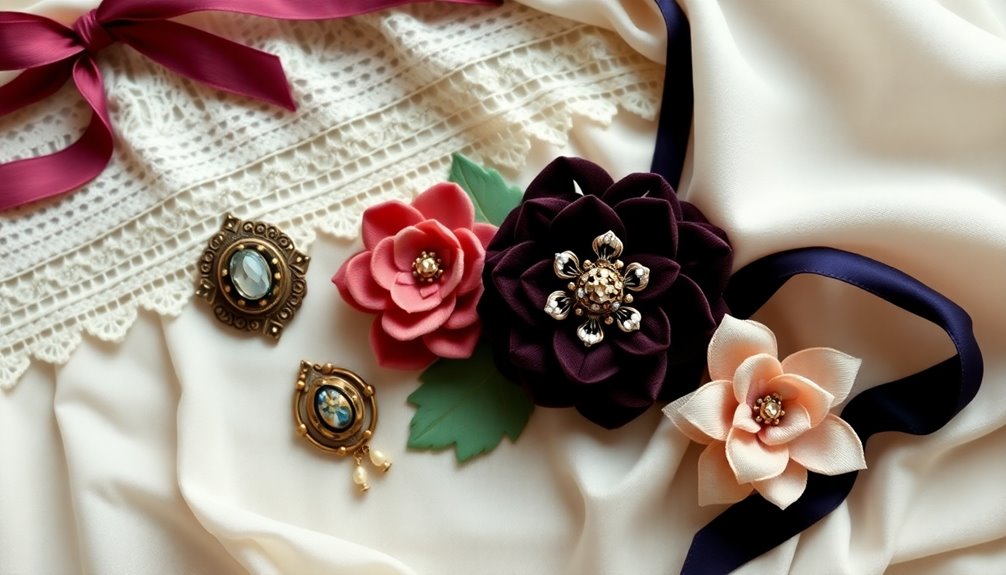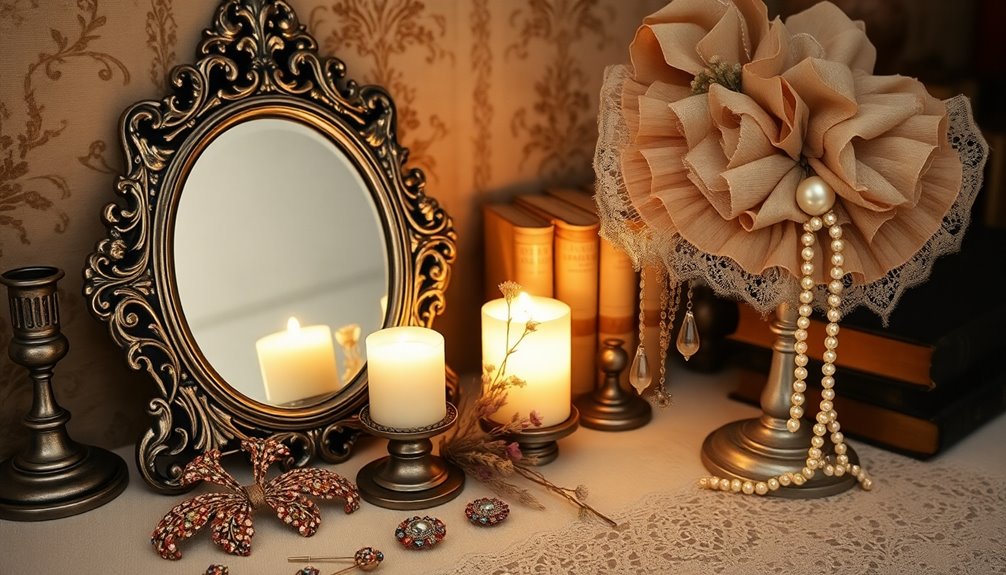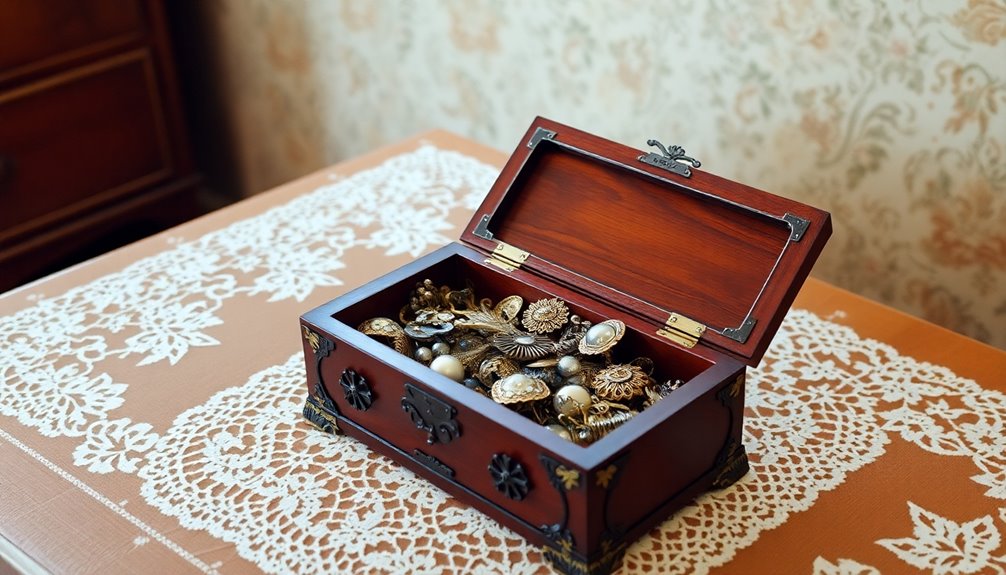You can easily transform modern finds into charming Victorian accessories through creative upcycling projects. Start by exploring thrift stores for hidden gems like old tote bags or leather purses. Turn these into unique items, such as flower wreaths or stylish fanny packs. Don't overlook old clothing—repurpose wool scarves into cozy throws or transform old shoes into quirky planters. Use techniques like decoupage to add vintage flair to surfaces, and enhance the look with rich colors and textures. If you're eager for more ideas and techniques, there's plenty of inspiration waiting for you to uncover.
Key Takeaways
- Transform thrift store finds like brooches and ribbons into charming Victorian-style hair accessories or brooch bouquets.
- Repurpose old silk scarves into stunning, chunky necklaces for a vintage-inspired fashion statement.
- Convert small leather purses into trendy fanny packs adorned with Victorian embellishments for a unique accessory.
- Use vibrant floral-patterned fabric remnants to create decorative elements like pillow covers or table runners that reflect the Victorian aesthetic.
- Upcycle old shoes into quirky planters or display pieces, adding a whimsical touch to your home decor.
Thrift Store Finds and Transformations

Thrift stores often hold hidden gems waiting to be transformed into stunning Victorian accessories. You can find bags, purses, and shoes that inspire your creativity. For instance, consider converting an old tote bag into a charming wreath by filling it with seasonal flowers.
If you stumble upon a small leather purse, grab some leather crafting tools and turn it into a trendy fanny pack.
Don't overlook scarves and fabrics, either. A silk scarf can effortlessly become a chunky necklace, while wool scarves stitched together make a cozy patchwork throw blanket. You might even use scarf material to embellish plain accessories like tote bags and hats, adding a unique flair. This process of upcycling is not only a great way to express your creativity but also helps reduce waste in landfills.
And let's not forget footwear! Old shoes can serve as quirky succulent planters or decorative displays. Upcycling Victorian-style boots with lace and hot glue can create eye-catching pieces for your home.
With a little imagination, the items you find at thrift stores can transform into delightful accessories that reflect the Victorian charm you adore. Dive into the treasure hunt and see what you can create!
Victorian Home Decor Ideas

Transforming your home into a Victorian masterpiece starts with embracing rich colors and luxurious textures. Choose darker hues like burgundy, navy, olive green, or mustard to paint your rooms, creating a dramatic backdrop. To enhance the Victorian style, consider using brightly colored floral-patterned wallpapers. Multicolored walls can add vibrancy to your living space, but balance bold colors with neutral tones to keep the atmosphere inviting.
Next, elevate your lighting with bold fixtures. Incorporate LED candle tapers, candelabra, and wall sconce candle holders to create a warm, vintage glow. Luxurious lighting choices contribute significantly to the overall decor theme, ensuring that your space feels both inviting and elegant.
Don't overlook ornate chandeliers and ceiling medallions, which add elegance and charm. Textiles play a crucial role in achieving the Victorian look. Use plush fabrics for drapery, decorative pillows, and throw blankets to create a cozy environment. Flowing tablecloths and textured curtains will further enhance the aesthetic, while sleek minimalist furniture can contrast beautifully with tufted and fringed upholstery.
Decoupage Techniques for Vintage Charm

To complement your Victorian decor, incorporating decoupage techniques can add a touch of vintage charm to your furnishings and decor items. Decoupage is the art of decorating objects by gluing colored paper cutouts onto various surfaces, creating a stunning effect that resembles painting or inlay work.
You'll need materials like colored paper, Mod-Podge, and decorative elements to get started.
Begin by carefully separating napkin plies to avoid tears. Apply a thin coat of matte Mod-Podge to the surface before placing the decoupage paper. Use saran wrap to smooth out wrinkles, and if you're working with fabric napkins, ironing can help eliminate creases.
Take your time applying the paper to ensure even adhesion and avoid air bubbles. Additionally, the versatility of decoupage application allows you to enhance various surfaces, including wood, glass, and fabric.
To enhance your project, try layering paint and using Saltwash for a distressed look or add crackle effects for that rustic charm. You can also explore specialized techniques like fire burning napkin decoupage for unique designs or work on metal surfaces for a different style.
Don't forget to join decoupage communities for tips and inspiration to refine your skills!
Upcycling Lamps and Lighting

How can you breathe new life into old lamps while adding a touch of Victorian elegance? Start by scouring thrift stores for unique lamp bases. Once you've found a suitable piece, remove the existing lampshade and replace it with new or repurposed materials.
Consider using curtain rings or creating a skeleton shade for an authentic look. To enhance the vintage charm, apply antiquing wax and sand the finish for that aged appearance.
If you have non-functional lamps, transform them into decorative hanging candle fixtures. Use hot glue to secure components, ensuring the structure remains intact. Vintage-style lighting elements, like ornate fittings or metal tubing, can elevate the design.
Don't forget to paint or stain your lamp to match Victorian color schemes. Integrate Victorian-inspired materials like velvet or lace for added texture. Rub-on transfers featuring intricate designs can update your lamp's appearance.
As a finishing touch, distress the lamp to give it an antique look. Remember to update electrical components for safety, and wrap bases with twine or ribbon for that rustic touch. Additionally, incorporating unique pieces in your decor can create focal points and conversation starters.
Display your upcycled lamps prominently to showcase their unique charm!
Textile Repurposing Projects

Countless opportunities await when it comes to textile repurposing projects, allowing you to breathe new life into fabric scraps and old clothing. You can create patchwork quilts from meaningful items like old jeans or baby clothes, turning sentimental pieces into cozy treasures. Additionally, you can craft a cozy denim quilt from old jeans, showcasing both comfort and sustainability with a popular upcycling project. Chia seeds, known for their nutritional power, can inspire you to incorporate health-conscious elements into your crafting sessions.
If you have smaller scraps, consider making appliqués to spruce up children's clothing or cover up pesky stains. For fun and functional projects, transform fabric into soft plush toys, like bears from outgrown baby clothes. You can also craft fragrant scented sachets filled with potpourri, perfect for closets or as thoughtful gifts.
Don't forget about practical items like mug rugs, which add charm to your coffee breaks. When it comes to clothing, old jeans can morph into stylish shopping bags or mobile pouches. T-shirts can become trendy drawstring backpacks, while old sweaters can be stitched into warm blankets or even fleece pet beds.
Lastly, you can make useful items like cable organizers or decorative planters from leftover fabric. With these textile repurposing projects, you'll not only reduce waste but also create unique, cherished pieces for your home and wardrobe.
Creative Uses for Old Accessories

Old accessories can be a treasure trove of creativity, offering endless possibilities for repurposing. For instance, those scuffed shoes you can't bear to toss? Transform them into quirky succulent planters for your porch. You can also glue old shoes together, embellish them with lace, and create a charming Victorian display alongside other vintage items.
Don't overlook bags and purses, either. A thrift store tote can become an unexpected front door wreath when filled with flowers. Small leather purses can be upgraded into stylish DIY fanny packs. You can even patch up blemished bags with vintage travel patches for a unique look.
Scarves are versatile too! Stitch together wool scarves into a cozy patchwork throw blanket. Or, transform silk scarves into chunky necklaces for a contemporary flair. With a little creativity, scarves can even turn into delightful sun catchers or seasonal decor.
Lastly, don't let old belts and jewelry go to waste. Use ribbon belts as embellishments on bags or hats, and transform jewelry pieces into new accessories. Old accessories can find new life in your home, blending vintage charm with modern creativity. Additionally, embracing continuous learning can inspire innovative ways to upcycle and enhance your projects.
Antique-Inspired Display Techniques

Creating an antique-inspired display allows you to showcase the beauty of vintage items while infusing your space with character.
Start by repurposing old shoes or boots as unique display pieces. Stabilize them with glue and embellish with lace or decorative elements, turning them into eye-catching holders for small items. Consider incorporating aesthetic hooks to further enhance your display and utilize vertical space effectively.
Next, consider using decoupage techniques to enhance surfaces. Begin with a black-painted base to seamlessly blend any uncovered areas. Thrift store treasures can be a great source for unique papers and embellishments to use in this process.
Apply decoupage with a scotch glue stick, trimming excess paper carefully to avoid bulkiness. Combine this with staining or painting for a layered effect that screams Victorian charm. To enhance the Victorian aesthetic even further, consider incorporating elements like lace trim or vintage buttons that echo the ornate designs of the era. Additionally, sprinkle on some decorative flourishes, such as British sprinkles and their history, which can transform a simple decoupage project into a stunning homage to the past. The combination of textures and colors will not only elevate your artwork but also weave together a narrative that celebrates the rich traditions of Victorian craftsmanship.
Adding embellishments is key. Use hot glue to secure beads, pearls, or ribbons, creating a polished finish.
Sand surfaces to remove any unwanted shine, ensuring a sophisticated look. Display your upcycled treasures on dark wood or complementary materials to highlight their antique appeal. Consider how effective wall organization can enhance the overall presentation of your displays.
DIY Victorian-Style Curio Boxes

If you want to add a touch of Victorian elegance to your home, DIY Victorian-style curio boxes are a perfect project.
Start by sourcing wooden shelving pieces, boxes, or empty drawers from thrift stores. Clean these thoroughly, then stain or paint them with a deep color like Minwax "Ebony" to give a unified look. Sand down rough edges and re-stain if necessary. These boxes are ideal for displaying mismatched thrift store finds that add a unique touch to your decor. To ensure durability, select materials that are known for their high satisfaction in user ratings.
Next, enhance your boxes with decorative papers or fabric. Measure and trim decorative papers to line the inside backs, or use black velvet fabric to create custom slots for jewelry.
For added charm, consider applying a stained glass effect window film to cover glass panels.
When assembling, attach hooks and hanging hardware for wall mounting. Create partitions using plywood and velvet for earrings and place small hooks for necklaces.
Don't forget to use foam from old mattresses for custom fittings, ensuring your items stay secure.
Enhancing Modern Pieces With Lace

Transforming modern garments with lace can elevate their style and add a touch of vintage charm. Start by sourcing vintage lace from thrift stores or antique fairs, ensuring it complements the garment's silhouette, like a round or V-shaped neckline. Upcycling through this process not only enhances your wardrobe but also promotes eco-friendly practices and sustainability in fashion.
If the lace needs brightening, soak it in a water-chlorine mix before using it. Baste it loosely to prepare for stitching.
When you're ready to attach the lace, use a sewing machine with a reverse pattern foot and a straight stitch. Finish the trim edges by hand for a polished look. Lace can enhance a variety of garments, including tops, blouses, and t-shirts, making them uniquely yours.
If you're looking to repair damaged lace, assess the areas needing attention and use basting thread to stabilize before stitching. Consider creative solutions like flipping the design elements to showcase undamaged parts.
Always handle lace gently to prevent fraying, especially when cutting.
Transforming Footwear Into Decor

Old footwear can become a charming focal point in your home decor. You can easily transform old shoes into curio displays by gluing the bottom and back together, creating a unique box.
Decorate the exterior with paint or decoupage for a refined look, then fill the shoe with small curios like jewelry or crystals. Consider lining the inside with foam or velvet for added elegance.
Alternatively, scuffed shoes can find new life as quirky planters. After cleaning them, simply add soil and your favorite succulents. These shoe planters can brighten up your porch or indoor spaces with a touch of nature.
Don't forget about vintage boots! Restoring these treasures can showcase their natural charm. Just glue the bottom and back, and consider adding lace or other embellishments for a refined touch.
Lastly, upcycle children's shoes as sentimental decor. Paint or decorate them to match your theme, adding ribbons or mementos for a personal touch.
Display these upcycled shoes in a memory box or on a shelf, preserving precious memories while enhancing your decor.
Seasonal Upcycling for Home Decor

Seasonal upcycling can breathe new life into your home decor, allowing you to celebrate each time of year with creativity and flair.
Start by repurposing seasonal storage, like creating a fall-themed caddy with minimal paint and natural wood accents for year-round use. Scour clearance sales for items that can elevate your decor without breaking the bank, and consider converting old storage cubbies into charming displays for mugs and pitchers. Thrifty Style Team contributors provide a plethora of ideas to inspire your own DIY projects.
As autumn approaches, transform old sweaters into cozy fabric pumpkins or wreaths. Glass jars and bottles can easily become lanterns or vases with a simple fall theme. Use cardboard and paper to craft templates for your seasonal decorations, and don't forget to incorporate natural elements like leaves and acorns for an authentic touch. Using wood as a renewable resource can add a sustainable element to your decor projects.
Get creative with materials, turning broken dishes into decorative bird baths or upcycling wooden bowls with bleach for unique pieces. Add twine or ribbon for those finishing touches.
Frequently Asked Questions
What Tools Are Essential for Upcycling Vintage Items Effectively?
To upcycle vintage items effectively, you'll need essential hand tools like pliers, hammers, and screwdrivers, along with power tools like drills and sanders. Don't forget clamps, chisels, and paint brushes for finishing touches!
How Do I Choose the Right Thrift Store Items for Upcycling?
When you choose thrift store items for upcycling, look for unique features, assess their condition, consider materials, and envision how they'll fit your style. Multi-purpose and adaptable items offer the most creative potential.
Can I Mix Modern and Vintage Styles in My Accessories?
Absolutely, you can mix modern and vintage styles in your accessories! Just ensure you balance both elements to create harmony. Use modern items to complement vintage pieces, enhancing the overall aesthetic without overwhelming the space.
What Safety Precautions Should I Take While Upcycling?
When upcycling, you should wear protective gear, work in well-ventilated spaces, and inspect items for hazards. Use safe materials, test for lead, and dispose of any toxic waste properly to ensure your safety.
How Can I Maintain the Functionality of Upcycled Items?
To maintain functionality in upcycled items, use original materials, reinforce weak areas, and optimize design adjustments. Ensure all parts are securely attached and test the item to confirm it withstands regular use.
Conclusion
By embracing these DIY Victorian accessory projects, you can effortlessly blend modern pieces with vintage charm. Whether you're transforming thrift store finds or repurposing textiles, each creation adds a unique touch to your home. Don't shy away from experimenting with decoupage, lace, or even footwear—your imagination is the limit! With a little creativity, you can bring elegance and character into your space, making it truly one-of-a-kind. Get started on your upcycling journey today!









